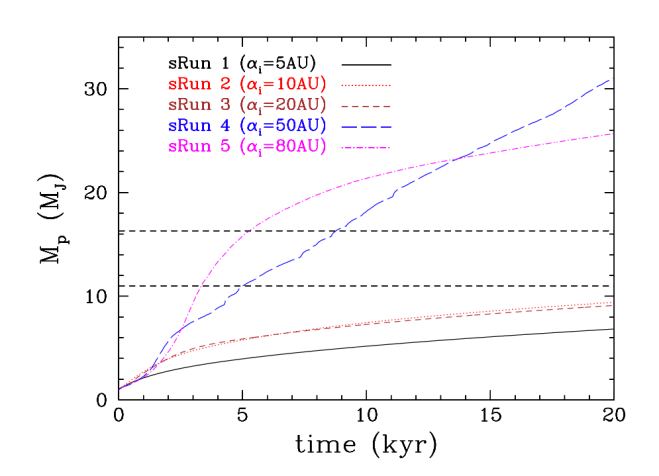Title: The diverse lives of massive protoplanets in self-gravitating discs
Authors: Dimitris Stamatellos, Shu-ichiro Inutsuka
First Author’s Institution: Jeremiah Horrocks Institute for Mathematics, Physics & Astronomy, University of Central Lancashire
Status: MNRAS accepted, [open access] http://www.star.uclan.ac.uk/~dstamatellos/Publications_files/protoplanets.pdf
It is remarkable to think of the effects every detail of every cosmic event can have. Every celestial body we observe today, within our Solar System and beyond, was formed and shaped by the events that came before, out of the properties of the space it formed out of. Today’s paper uses a unique style of simulation to expound on the question, what made the exoplanets we detect today? What process did they come out of? Specifically, the focus is placed on the case of the gas giant exoplanets more easily detected and commonly observed today.
Chronologically, Safronov, Goldreich & Ward, Mizuno, Bodenheimer & Pollack, and Pollack et al. have proposed a model of core accretion; they suggest a massive core, several times the size of the Earth’s, forms out of the coalescing of dust and space material over time. The resulting gravity of this core then draws in the envelope of gas. This model, however, is problematic in that the process it describes would take millions of years, outliving the circumstellar discs of most stars observed today, and failing to explain the peculiarly wides orbits of many of these planets.
Rather, this paper draws upon and gives support to a second theory, that these planets may also form out of the gravitational fragmentation of protostellar disks. This theory holds that, once a fragment forms inside of such a disk (assuming the disk is of a certain mass and gravity), it begins to move around, collecting gas, increasing in mass and causing a gap to open within the disk. It is hypothesized that if the resulting body is ejected near that point, it becomes a normal planet, of an accepted planetary size. If it continues within the disk, however, it may evolve into a gas giant, or continues to accrete at such a rate that it exceeds the mass-limit, or ignites deuterium, elevating its status to a brown dwarf. Such seeds are labeled ‘protoplanets’ in this paper’s study due to the mystery of their futures. Such a theory would be valuable because it would provide the basis for a more dynamic timescale for the planet’s formation (as short as 10,000 years), as well as explaining the formation of the wider-orbiting planets referenced earlier.
Whether or not such a process is possible, however, and whether or not the likelihood of a fragment surviving as a planet is convincing and robust enough to make this a reliable model, is explored in this paper’s computational simulations. The estimates used are conservative, at the lower bounds of what former papers deem necessary for disk fragmentation. The initial seed is estimated to be the size of Jupiter, and it is inserted into a stable, circular protostellar disk that has been at rest for ~3kyr.
The first simulation has five runs, wherein parameters are adjusted to account for variances in the protoplanet’s radiative feedback, the disk’s viscosity, inclinations in the protoplanet’s orbit around the central star, and factoring in “Seminov opacities”, or differences in the size and composition of particles within the disk.
Figure 3 (included below) demonstrates the changes in the protoplanet’s mass as the simulation runs for 20kyr. The horizontal dashed lines represent the upper and lower bounds for the classifications of a brown dwarf (defined as M = 11-16.3 times the initial mass, around the size of Jupiter). This graph demonstrates that accretion ticks off rapidly as a gap is opened within the disk, leading the planet to evolve into a brown dwarf over the course of the simulation in every run except the second. In that case, the planet’s radiative feedback (i.e. the mechanisms it uses to maintain an equilibrium within its atmosphere) suppresses the process of accretion sufficiently enough to halt or slow down its evolution into a brown dwarf, potentially keeping it within the bounds of what is considered planetary.

In another simulation, the protoplanet is inserted at various distances from the center of the disk. The changes in mass are represented in figure 21, included below. Here, the horizontal lines refer to the bounds at which it is assumed the body might ignite demetrium, and therefore be considered a brown dwarf. In runs 1 and 2, where the protoplanet forms closer to the center of the disk, it is less likely to reach that limit over the course of the simulation.

Ultimately, what becomes clear from this study is that a variety of properties, from the surrounding physical processes (read: the potential for radiative feedback), and the initial conditions of the fragment (read: its orbital distance), ultimately determine its fate. This paper is made even more valuable by the fact that it sets up an avenue for studying, incorporating further, the study of even more properties, and the effects they may have in determining the futures of even the tiniest planetseeds. They may end up “a massive giant planet on a circular orbit close to its parent star or as a low- or high- mass brown dwarf on an eccentric wide orbit”.
In the end, it all connects. The scientific marvels astronomers observe are never random, rather they are calculable effects of intricate, ongoing processes, that have shaped and will continue to shape the universe as we know it for eons to come. Every planetseed and protoplanets circumambulating in a protostellar disk today has reason to reach for the stars: it could become a wondrous exoplanet, with its own unique properties to contribute to our star systems and galaxies, or it could very nearly become one!
Works Cited:
Stamatellos, Dimitris, and Shu-ichiro Inutsuka. “The Diverse Lives of Massive Protoplanets in Self-Gravitating Discs.” Eprint ArXiv:1804.00583, Apr. 2018, http://www.star.uclan.ac.uk/~dstamatellos/Publications_files/protoplanets.pdf.